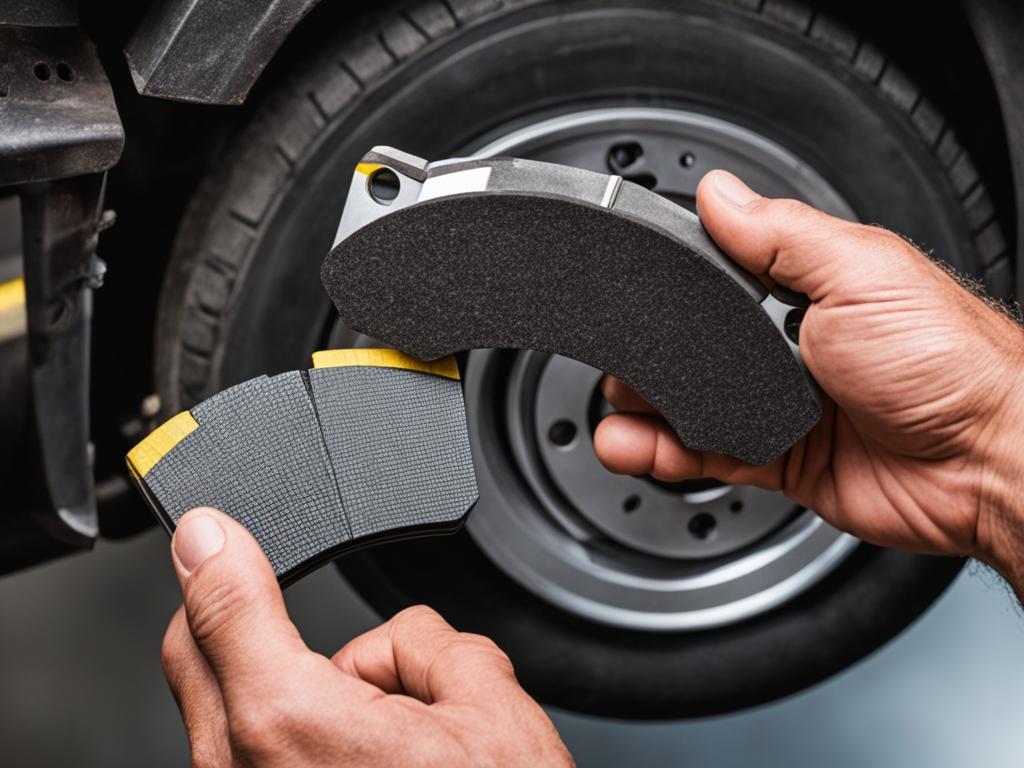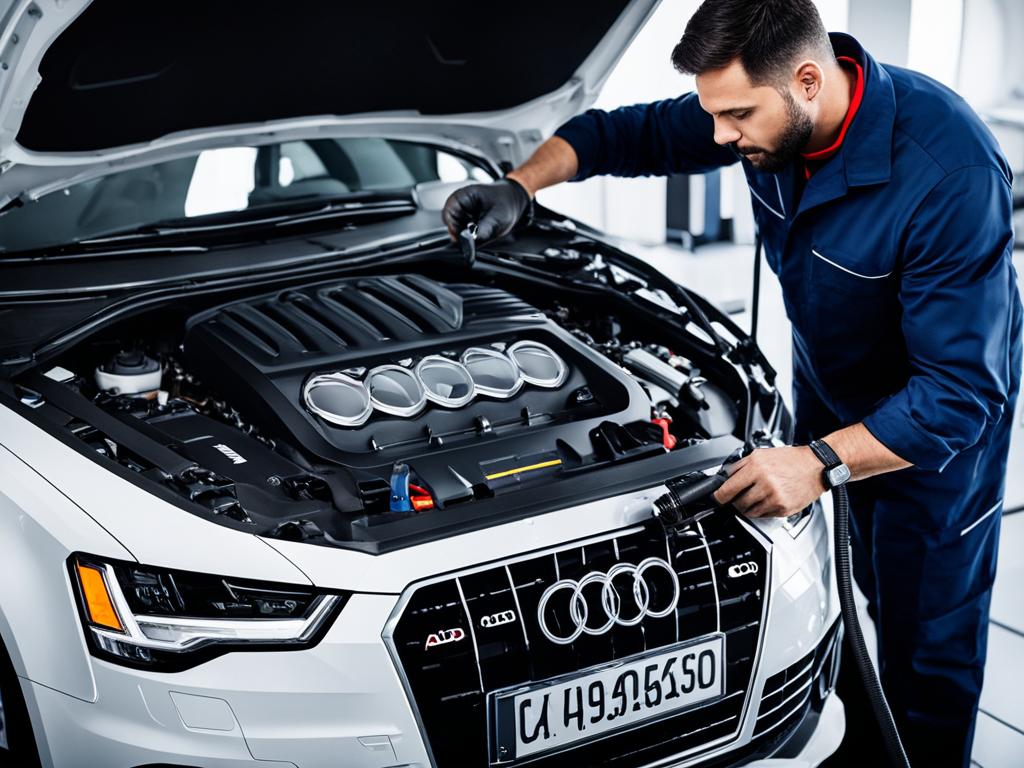Audi EPC Light Car Shaking: Quick Diagnostics Tips
When your Audi’s performance is compromised with symptoms like the car shaking at idle or car shaking when accelerating, it can be an unsettling experience. Among the spectrum of dashboard signals, the Audi EPC light problem stands out. This warning could indicate an intricate network of issues impacting your vehicle’s Electronic Power Control, signaling that swift action is necessary to maintain your car’s functionality and safety. Modern vehicles in the Volkswagen Group, including Volkswagen, Porsche, and Audi, are equipped with this advanced system to precisely manage engine and ignition operations. Instantaneous diagnosis and preventive measures are paramount to sidestep potential critical failures, such as an Electronic Stability Control (ESC) system collapse or complications related to the airflow sensor.
Key Takeaways
- Recognize the seriousness of the Audi EPC light and its association with your car’s shaking.
- Identify common reasons why your Audi may shake during acceleration or at idle.
- Comprehend the extensive systems monitored by the EPC, including throttle position and traction control.
- Take timely measures to avert aggravated damage by acknowledging these warning signs.
- Seek professional insight to ensure that any issue is addressed with accuracy and expedience.
Understanding the Audi EPC Light and Its Implications
When the Audi EPC light illuminates, it serves as a critical warning signal to the driver. Understanding the Audi EPC light meaning is essential, as it communicates that your vehicle’s Electronic Power Control system has identified an issue within its spectrum of monitored components. Primarily, the EPC light addresses problems related to the throttle system and engine ignition sequence.
The implications of the EPC light can range from minor sensitivity adjustments to severe malfunctions. Among these difficulties, electronic stability control issues are particularly concerning. This integral feature helps maintain traction on slippery roads by automatically applying brakes to individual wheels, thereby preventing skidding or loss of control. An EPC warning can mean that this vital safety system has been deactivated due to some underlying issue.
In instances where the EPC light persists, an Audi vehicle may enter “limp-home” mode – a precaution engineered to protect the engine and allow the driver to safely reach a service destination. While in limp-home mode, the vehicle’s power is significantly decreased which limits its performance capabilities. This mode ensures that the driver can navigate to a mechanic under controlled conditions, minimizing the potential for further damage.
A steadfast awareness of the EPC system’s function and its associated warning signs can be the difference between a quick fix and an expansive repair. Paying heed to the EPC light can spare extensive engine wear and promote vehicle longevity.
Outlined below is a table providing a concise comparison of Audi EPC light scenarios and their possible implications:
| EPC Light Status | Possible Implication | Recommended Action |
|---|---|---|
| EPC Light On | Minor Control Issue | Check throttle and cruise control systems |
| EPC and Stability Control Lights On | Stability Control Deactivation | Seek immediate inspection for ABS/ESC systems |
| EPC Light On + Limp Mode Activated | Severe Malfunction | Drive cautiously to a certified mechanic |
The importance of addressing the warning signaled by the EPC light must not be underestimated. It is an advanced alert system designed to inform the driver of the need to diagnose and rectify electronic stability control concerns. A proactive approach in understanding and responding to these signals is indispensable for maintaining the performance and safety of your vehicle.
Common Causes of Car Shaking Linked to the EPC Light
There are several key factors behind car shaking at high speeds, car shaking when braking, and engine misfires, which are commonly linked to the illumination of the EPC light in vehicles. These issues can stem from a variety of mechanical and electronic malfunctions that require immediate attention for the safety and proper functioning of the vehicle.
Engine misfires are often the result of defective ignition components, such as spark plugs or ignition coils. Such misfires compromise engine stability and can induce vibrations that are felt throughout the vehicle. Moreover, braking issues that lead to car shaking usually involve problems with the brake system components—the pads, rotors, or calipers—particularly noticeable at higher speeds. Unbalanced tires and misaligned wheels are also culprits, causing the vehicle to vibrate during motion. To ensure a smooth driving experience and maintain the vehicle’s integrity, it is essential to diagnose these issues correctly and address them promptly.

| Potential Issue | Symptoms | Vehicle Components Involved |
|---|---|---|
| Engine Misfires | Juddering, sudden loss of power, uneven engine sound | Spark plugs, ignition coils, fuel system |
| Braking Issues | Vibrations when braking, squealing noises, longer stopping distance | Brake pads, rotors, calipers, brake lines |
| Tire/Wheel Imbalance | Shaking at higher speeds, uneven tire wear, steering issues | Tires, wheels, suspension system, steering components |
The aforementioned table outlines the various scenarios in which a vehicle may exhibit shaking while linking them to the EPC system’s alert. Drivers experiencing such issues should not overlook the need for a thorough inspection, and if necessary, seek professional assistance to ensure any underlying problems are resolved efficiently.
Initial Steps for Troubleshooting Your Audi’s Shaking Issue
Addressing the unsettling experience of your Audi shaking when accelerating can often begin with some essential diagnostics that any informed car owner can perform. Before delving into more complex areas, some preliminary checks can help isolate the issue, saving time and possibly expensive visits to the mechanic.
Visual Inspection for Obvious Damage
Commence with a straightforward visual examination of your vehicle. Inspect for apparent signs of distress and damage that may contribute to the shaking. Key components to scrutinize include:
- Engine mounts: Check for any cracks or deterioration that could lead to excessive engine movement.
- Tires: Look for signals of wear or imbalance which could induce vibrations.
- Brake pads: Overlooked brake pad wear can surreptitiously cause judders, especially when the brakes are applied.
Sometimes, even the most inconspicuous discrepancies can manifest as significant shaking during a drive, underscoring the importance of this simple yet effective step.
Checking for Diagnostic Trouble Codes with an OBD-II Scanner
After a preliminary visual check, employ an OBD-II scanner to hunt for any diagnostic trouble codes (DTCs). These codes are pivotal clues that your car provides when an error occurs within any of its systems. They are particularly beneficial for identifying:
- Ignition-related defects, often linked to discernable ignition coil symptoms such as misfiring or loss of power.
- Problems stemming from the engine or emission systems that can cause increased vibrations.
Paying heed to these codes can swiftly guide you towards the right corrective measures and get your Audi running smoothly on the roads once more.
Audi EPC Light Car Shaking: Decoding the Symptoms
When your Audi alerts you with an EPC light flashing, it’s not just a signal to check your vehicle; it’s a direct call to action to prevent potential damage to your car’s intricate systems. This light indicates a critical issue, often related to the vehicle’s ability to control the engine’s power. One of the systems that might be affected includes the traction control, an essential safety feature that could experience a traction control malfunction, endangering your vehicle’s handling capabilities.
Another critical element tied closely to the EPC light is the throttle position sensor. This sensor feeds your car’s computer system with data to regulate fuel mixture and engine performance. Should this sensor fail, it may manifest as fluctuating engine power or unpredictable acceleration, both of which can lead to a shaky driving experience. Pinpointing these issues promptly is vital in maintaining not just the performance, but also the safety of your vehicle.
The symptoms accompanying a flashing EPC light may vary, but a common thread links them back to the car’s automated system controls—specifically related to engine management and power control. Too often, an underlying issue could be silently escalating, only showing subtle hints through vehicle shake or an occasional light flicker. Serious issues demand a more profound diagnostic approach to uncover the true cause beneath the symptoms and resolve them adequately.
Below is an outline of what each symptom could indicate:
- Consistent EPC light illumination: Suggests a persistent issue waiting for diagnosis.
- EPC light flashing alongside other warning indicators: Points to multiple system irregularities, potentially severe.
- Car shaking at idle or when accelerating: May be reflective of misfires or throttle system problems.
- Sudden loss of power or erratic acceleration: Anomalies within throttle control or traction systems could be at play.
Understanding these signs can provide clarity in navigating through the fault-finding process—ensuring that your Audi remains not just a symbol of excellent engineering but a bastion of reliability and safety on the road. Seeking professional insight is crucial when it comes to deeper electronic issues requiring specialist tools and expertise.

Ignition Coil Failures and Misfires: A Frequent Culprit
Understanding the causes behind your Audi’s EPC (Electronic Power Control) light can help you pinpoint issues before they escalate. One common factor contributing to an illuminated EPC light and subsequent engine trouble is an ignition coil failure. Misfires within your vehicle’s engine system can produce a range of bad ignition coil symptoms, including erratic idling, loss of acceleration, and decreased fuel efficiency. These issues can be tied directly to a system misfire, which, should it occur, stresses the urgency of repair to prevent further damage to your Audi’s engine components.
To diagnose and address an ignition coil failure effectively, a thorough inspection and testing are paramount. The list below highlights key symptoms and troubleshooting techniques to aid you in identifying potential ignition coil problems:
- Engine misfires leading to rough idling and stalling
- Lack of power during acceleration, indicating potential coil malfunction
- Engine noise or shaking, which can signal a misfire
- Poor fuel economy as a result of incomplete combustion
- Use of a spark tester to identify the faulty cylinder.
Once a faulty ignition coil is identified, replacement by a certified technician is the recommended course of action. Driving with a defective ignition coil can cause significant issues and lead your Audi to exhibit other warning signs, including those associated directly with Audi EPC light causes. Below is a table summarizing the symptoms and consequences of driving with a compromised ignition coil:
| Symptom | Potential Consequence |
|---|---|
| Engine misfires | Increased emissions, potential catalytic converter damage |
| Sluggish acceleration | Compromised driving experience, safety risk |
| Poor fuel economy | Increased operating costs |
| Engine noise and vibration | Added wear on engine components |
| Difficulty starting the engine | Potential for being stranded due to engine failure |
In conclusion, if your Audi exhibits any of the above bad ignition coil symptoms or if your vehicle’s EPC light illuminates, it is imperative to seek immediate professional assistance. Addressing ignition coil issues promptly can prevent more severe problems, ensuring the longevity and reliable performance of your vehicle.
Critical Role of Throttle Position and Airflow Sensors
One often underappreciated aspect of modern Audi performance lies within the complex interaction between the throttle position and airflow sensors. As intricate components of the engine management system, their prime function is to ensure smooth and efficient engine operation. However, when issues arise with these sensors, they can undermine not just the performance but also the stability of an Audi, manifesting in situations like the Audi EPC light meaning an immediate attention to these problems.
Understanding the Throttle Position’s Impact on Stability
The throttle position sensor plays a pivotal role by relaying the precise angle of the throttle valve to the Engine Control Unit (ECU). This interaction is crucial for modulating the fuel and air entering the engine, thus directly influencing throttle response. A malfunctioning sensor can send incorrect signals, leading to an erratic power delivery, which in turn, might result in sudden surges or hesitations in acceleration.

Airflow Sensor Malfunctions Leading to Irregular Engine Response
Equally critical to engine stability is the airflow sensor, tasked with measuring the volume and density of air entering the engine. Any disruption in its function can lead to airflow sensor issues, often causing imprecise engine timing and air-fuel mixtures. Such irregularities can cause the engine to shudder, potentially shaking the entire vehicle and illuminating the EPC light as a warning to the driver of these deviations from normal operation.
Understanding these key components and their symptoms not only aids in identifying problems quicker but also underscores the importance of regular vehicle maintenance. To ensure the longevity and reliability of your Audi’s performance, attention to the throttle position and airflow sensors should be a part of routine checks carried out by professionals.
When Braking Causes Shaking: Exploring Brake System Issues
Experiencing car shaking when braking is more than just an unnerving annoyance; it can be a symptom of underlying issues within your vehicle’s brake system. In the quest for a safe and smooth ride, understanding and addressing the causes of this vibration is paramount. Common sources of brake-induced shaking include brake pad uneven wear, compromised brake rotors, and a lack of proper lubrication. These discrepancies in the brake system not only affect comfort but also compromise the safety and performance of your vehicle.

A comprehensive brake system inspection is crucial to diagnose the root cause of the shaking. During this examination, every component of the brake system is scrutinized, from calipers to rotors, to ascertain their condition and functionality. Let’s delve into what this inspection encompasses:
- Inspection of brake pads for uneven wear and thickness variation
- Evaluation of rotor surface and structure for rust or warping
- Assessment of calipers and related hardware for proper operation
Regular maintenance and prompt attention to these issues will not only reduce occurrences of car shaking when braking but will also extend the lifespan of your entire brake system. Evidently, a holistic approach to brake system health is integral to ensuring a vehicle’s optimal stopping capabilities and overall dynamic stability.
Engine Mounts and Drivetrain Elements: Vibration Generators
To preserve the smooth operation of your vehicle, it is essential to address and minimize vibrations. This begins with a thorough examination of two pivotal parts of your car: the engine mounts and the drivetrain components. Below we delve into how to diagnose and assess the integrity of these vital elements.
Examining Engine Mount Condition
Engine mounts, also referred to as motor mounts, play an indispensable role in anchoring the engine to the vehicle’s frame, while also dampening the noise and vibrations naturally produced during operation. Overtime, broken engine mounts can result in excessive engine compartment motion, thereby leading to other mechanical issues. A visual and physical check will reveal if the engine moves more than it should when revving slightly, indicating the need for repair or replacement.
Assessing Drivetrain Components for Integrity
The drivetrain is a complex system that transmits power from the engine to the wheels, and any disruption within this system can cause drivetrain vibrations. These vibrations may be especially noticeable during acceleration. It’s crucial to regularly inspect components such as the transmission, CV joints, and drive shaft for wear or damage.
Regular maintenance checks and being attuned to your vehicle’s performance are indispensable for preventing and diagnosing shakes and vibrations. Recognizing the signs of wear or failure early can safeguard against more extensive repairs down the line.

| Component | Common Issues | Signs/Symptoms | Suggested Solutions |
|---|---|---|---|
| Engine Mounts | Cracks and Wear | Excessive engine movement, noise under acceleration | Replacement with OEM parts |
| Transmission | Leaking fluids, misalignment | Difficulty shifting, unusual noises | Sealant repair, realignment |
| CV Joints | Wear, tears in CV boots | Clicking noise when turning | Inspection and replacement of CV joints or boots |
| Drive Shaft | Imbalance, U-joint failure | Vibration at certain speeds, clunking sounds | U-joint repair, drive shaft balancing |
Tire Balance and Alignment: Easily Overlooked Factors
When diagnosing reasons behind a steering wheel shake, it’s important not to overlook fundamental factors such as tire balance and alignment. Imbalanced tires can significantly contribute to vibrations felt throughout the steering wheel, signaling a need for immediate attention. Similarly, improper tire alignment can not only affect your control and comfort but also has the potential to create excessive strain on suspension and steering components. These issues, left unchecked, can lead to a wider range of automotive complications.

Ensuring a thorough inspection and regular maintenance can help preserve the intricate relationships between tires, suspension, and steering systems. Here’s a breakdown of why these factors matter:
- Tire Balance: A wheel is out of balance when one area is heavier or lighter than the rest. This causes the wheel to wobble or spin unevenly, which is felt as a vibration.
- Tire Alignment: Alignment refers to the adjustment of a vehicle’s suspension – the system that connects a vehicle to its wheels. Proper alignment ensures that your tires meet the road at the right angle.
- Suspension System: A car’s suspension system is designed to provide a smooth ride and to keep the tires in contact with the road. Wear or damage to suspension components can greatly impact wheel stability.
Addressing these aspects with precision is not only crucial for driving comfort but also for the overall health of your vehicle. Technicians typically use a tire balancing machine to pinpoint the heavier areas and compensate by attaching small weights to the rim. For alignment, specialized equipment is required to adjust the angles of the wheels so they are perfectly parallel to each other and perpendicular to the ground.
Remember, regular tire rotations and alignment checks are your best defence against the common yet oft-ignored issues of tire balance and alignment. Heed the signs and give these components the attention they deserve.
Diagnosing Fuel System Faults: Injectors, Pumps, and Filters
Any seasoned mechanic knows that a car’s performance is as good as its fuel system’s operation. Frequently, drivers encounter issues like fuel injector clogs, which can lead to engine stutter and an overall rough driving experience. It’s critical to understand how to check for these problems and ensure your vehicle’s engine remains in peak condition. Comprehensive diagnostics targeting the fuel injectors, pumps, and filters can unearth fuel pressure issues and prevent the dreaded engine shakes that spell trouble on the road.

Ensuring Adequate Fuel Delivery with Injector Tests
To prevent fuel injector clogs, a thorough inspection is a must. It’s not just about looking for a blockage – it’s also about ensuring the injector delivers fuel at the correct pressure and spray pattern. These factors are crucial for an engine to run smoothly without any engine stutter. An injector test can range from a simple fuel spray assessment to more advanced procedures like a pressure and leak-down test. This evaluation must be approached systematically to ensure accuracy and safety.
Fuel Pump and Filter Checks to Prevent Engine Stutter
When considering fuel pressure issues, the fuel pump and filter should also be closely inspected. A weak pump can starve the engine of fuel, while a dirty filter can obstruct flow, both leading to engine stutter. Periodic checks will not only extend the life of these components but also maintain fuel efficiency and performance. Simple steps like listening for the pump’s operation or checking fuel pressure with a gauge can save a motorist from bigger issues down the line.
Remember, regular maintenance is key. Don’t wait for signs of trouble like engine stuttering or shaking. Be proactive and keep your vehicle’s fuel system unobstructed and functioning at full capacity
Limp-Home Mode: The Vehicle’s Protective Response
Among the many sophisticated features of modern automobiles is the limp-home mode activation, a critical system designed for engine damage protection. This built-in safety protocol allows a vehicle to continue to operate, albeit in a reduced power operation state. It’s a measure taken to safeguard the engine from severe damage when a significant error or malfunction is detected.
Limp-home mode can be triggered by a multitude of issues ranging from sensor failures to software glitches. When activated, it essentially allows the vehicle to conserve its remaining operational capacities and ‘limp’ back to the nearest repair facility for assistance—a vehicular version of first aid.
The implications of limp-home mode go beyond merely indicating a fault. It represents the vehicle’s capacity for self-preservation until proper maintenance can be provided. Here’s a concise overview of how this mode operates:
- Reduces engine power to minimize load and potential strain.
- Limits the speed at which the car can travel to prevent exacerbating the issue.
- Disables certain functions such as turbo boost to protect the engine.
- Activates diagnostic alerts to inform the driver of an immediate need for service.
Understanding when and why your vehicle enters limp-home mode is crucial for any driver. Not only does it signal the need for prompt attention, but it can also prevent more extensive and costly repairs that could arise from ignoring such warnings. Regular maintenance checks can help identify potential troubles before they escalate to the point of requiring limp-home mode to intervene.

“Limp-home mode is a testament to a vehicle’s resiliency, granting a chance to avoid engine catastrophe. Yet, it is by no means a substitute for consistent vehicle care. Prevention, as they say, is always better than cure.” – Automotive Expert on Engine Protection
In summary, while no driver wants to experience their car powering down to limp-home mode, it’s reassuring to know that such a system exists. It’s your vehicle’s way of communicating its limits while still striving to bring you to your destination—and mechanic—safely.
Seeking Professional Aid: When to Visit a Mechanic
Car owners understand the freedom and control that come with troubleshooting car issues from the comfort of one’s garage. However, not every warning sign can be solved through the Do-It-Yourself approach. Complex vehicle systems often require the sophisticated analysis and skilled intervention that only qualified technician assistance can provide. These experts bring an indispensable mix of experience, training, and access to specialized tools, which are critical for both diagnosing and resolving intricate problems. For situations involving persistent symptoms or when the vehicle’s safety is compromised, the insight of a professional can be the dividing line between a harmless issue and one that poses significant risks.
Identifying the Limits of DIY Diagnostics
DIY diagnostics carry their weight in gold for simple, straightforward problems. With a multitude of resources now available online, from forums to how-to videos, the average vehicle owner can tackle many minor issues. However, DIY diagnostic limitations become apparent with the advent of sophisticated technologies and computerized systems in modern vehicles. Intricate problems, such as diagnosing the cause of an erratic Audi EPC light or unraveling the reasons behind car shaking, can quickly exceed the purview of a non-professional. Recognizing when to step back and seek aid is as essential as the initial attempt at fixing a problem.
Finding a Qualified Technician for Complex Issues
Tracking down a qualified technician may seem daunting, but the peace of mind it brings holds immeasurable value. A reputable mechanic or a specialized automotive technician will provide a thorough professional vehicle inspection, saving you time and potentially expensive future repairs. They have the ability to interpret advanced diagnostic data, gauge the severity of the issue, and offer expert recommendations grounded in industry knowledge. Their expertise is particularly invaluable when the resolution requires nuanced troubleshooting that goes beyond replacing parts – the hallmark of complex automotive issues.

Conclusion
The journey to a serene and dependable driving experience with your Audi begins with recognizing and reacting to the early signals of potential issues, such as those indicated by the EPC light and associated vehicle shaking. The prompt and effective resolution of these issues is not just about convenience; it is about safeguarding the intricate systems that make your Audi the paragon of automotive excellence it is known to be.
Adhering to safe driving practices and committing to a schedule of regular vehicle maintenance form the cornerstone of automotive care that can prevent abrupt disruptions to your driving routine. A vigilant eye on changes in vehicular behavior, notably the illumination of the EPC light, equips Audi owners with the knowledge necessary to take decisive action and to mitigate the risk factors that could compromise both the vehicle’s performance and passenger safety.
Through understanding and addressing the causes that may trigger such warning lights and vibrations, Audi drivers ensure not just a resolution to episodic concerns but uphold the continuous excellence and operational safety of their vehicles. Remember, when the complexity of car issues extends beyond simple fixes, seeking assistance from qualified technicians can ensure that your Audi maintains the highest standards of performance and that you continue to enjoy the driving experience that is synonymous with this esteemed brand.
FAQ
What does the EPC light mean on my Audi?
The EPC light on your Audi stands for Electronic Power Control and is an indication that there’s a system malfunction relating to engine management such as ignition, throttle function, or computerized systems. It may require immediate attention, especially when coupled with symptoms like car shaking.
Why is my car shaking at idle when the EPC light is on?
Car shaking at idle with the EPC light illuminating could indicate issues such as engine misfires, vacuum leaks, or problems with engine mounts. It’s a sign that the vehicle has detected a fault in the power control system and is experiencing an unstable operation.
What should I do when my Audi shakes while accelerating and the EPC light is on?
If your Audi shakes when accelerating and the EPC light is on, it’s key to perform a basic visual inspection for any obvious damage, check for diagnostic trouble codes with an OBD-II scanner, and consult a professional mechanic if needed. The issue could be related to ignition coils, spark plugs, or other engine management systems.
Can the EPC light indicate a problem with the electronic stability control?
Yes, the EPC light may indicate a fault within the electronic stability control system. When illuminated, the vehicle may enter limp-home mode to reduce the risk of damage, and you might notice a loss of traction or stability control functionalities.
What causes my Audi to shake at high speeds?
Several issues could cause your Audi to shake at high speeds, including tire balance and alignment concerns, brake system issues, or problems with the suspension or drivetrain components. It’s essential to have these checked as they can seriously affect driving performance and safety.
What happens if driving with the EPC light on?
Driving with the EPC light on can be risky as the vehicle might be experiencing significant issues that could lead to a breakdown or loss of critical functionality such as throttle response or stability control. It’s best to investigate the cause of the warning light immediately and address any problems.
How do I troubleshoot car shaking related to the EPC light?
Troubleshooting car shaking related to the EPC light involves a methodical approach: begin with a visual inspection for noticeable damages, use an OBD-II scanner to read any diagnostic trouble codes, and systematically check potential areas like the ignition coils, engine mounts, tires and brakes. If the issue persists, seek professional help.
Why does my car shake when braking, and the EPC light turns on?
Car shaking when braking associated with an illuminated EPC light could signal issues within the brake system, such as warped rotors, worn brake pads, or caliper problems. It is essential to conduct a thorough inspection of the braking system to find and fix the root of the issue.
What role do the throttle position and airflow sensors play in my Audi’s operation?
The throttle position and airflow sensors provide critical data to the vehicle’s ECU for managing fuel and air intake for optimal combustion. If these sensors are malfunctioning, it can cause irregular engine responses, such as shaking, and potentially trigger the EPC light.
Can a bad ignition coil cause car shaking and the EPC light to illuminate?
Yes, a faulty ignition coil can cause car shaking and may result in the EPC light coming on. Bad ignition coils often lead to engine misfires, rough idling, and a general drop in vehicle performance.
What should I check if my car is shaking while accelerating?
When your car is shaking while accelerating, it’s important to check the condition of the ignition system, including spark plugs and ignition coils, as well as engine mounts and drivetrain components. Also, make sure there is no imbalance in the wheels and that the tires are properly aligned.
How can a professional mechanic help with the EPC light and car shaking issues?
A professional mechanic can use advanced diagnostic tools to accurately diagnose the issues behind the EPC light and car shaking. They have the expertise to interpret the trouble codes, carry out detailed inspections, and recommend appropriate repairs or part replacements.




